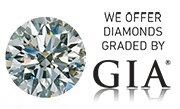Diamonds are universally graded on four basic characteristics.
These four characteristics are cut, clarity, color, and carat; thus the 4 C’s.
CUT
When diamonds are mined they are in a “rough” stage. It is up to a diamond cutter to to determine the best shape and cut for each stone, based on its rough appearance. The skill and expertise of a diamond cutter brings the stone to life, cutting it and polishing it to its best possible advantage. This is not only a technical process, but also a work of art.
A diamond that is cut well delivers three unique characteristics: fire, scintillation, and brilliance.
- Fire is the flash of colors that are emitted and visually seen as a diamond is rotated back and forth.
- Scintillation describes the pattern of light and dark areas and the sparkle seen when the diamond or observer moves.
- Brilliance is known as the light that is reflected off of a diamond’s interior and surface when exposed to light; the more light reflected, the higher the brilliance.
A diamond’s proportions affect its light performance, which in turn affects its beauty and overall appeal. Diamonds with fine proportions, symmetry, and polish optimize their interaction with light, and have increased fire, scintillation, and brilliance.
The diamond cut scale has 5 categories; excellent, very good, good, fair, and poor.
See more about diamond cut on GIA website
CLARITY
Clarity is a measure of a diamond’s blemishes and inclusions. It is extremely rare to find a diamond that lacks any internal or external characteristics. In fact, most stones have some. Because diamonds form under tremendous heat and pressure, these inclusions are usually made up of traces of gas, minerals or tiny fractures formed inside the diamond during its creation over millions of years. They effect the brilliance of diamonds and their sparkle because they interfere with the passage of light through the precious stone. These characteristics help gemologists identify individual stones. The GIA clarity Scale includes 11 clarity grades ranging from Flawless to I3 (See chart below).

CARAT WEIGHT
Originally the carat of a diamond was used as a measurement of weight, originating from the carob seed when it was used as a standard measurement of weight for gold. It eventually began to be used as the weight measurement of a diamond. The current standard states that a one carat diamond weighs 200 milligrams. As a diamond increases in size and carat weight, the price will increase at a incremental rate due to the fact that bigger/heavier diamonds are rarer; making them more valuable.
The term karat is used in reference to gold and its purity. 14 karat is less pure than 18 karat, and 24 karat gold is 100% pure gold.
See more about diamond carat weight on GIA website
COLOR
Diamonds exist in a variety of colors and hues. The color can range from clear all the way to black. Color grades are determined by comparing each diamond to a master set. Each letter grade represents a range of color and a measure of how noticeable a color is.
The internationally accepted standard for grading the color of diamonds consists two parts; the “normal color range” and the “colored diamond grading sytem”. The normal color range is used to grade clear to yellow/brown diamonds (D to Z). The colored diamond grading system is used to grade diamonds that do not fall into the normal color range. These stones are referred to as “fancy color” diamonds. A diamond’s Gemology Laboratory Certificate will explain its specific color and hue.
Some diamonds can emit a visible light when exposed to ultraviolet radiation, but fluorescence is not a factor in determining color or clarity grades. However, a description of its strength and color is provided on GIA reports as an additional identifying characteristic.
The value of a diamond is in part determined by its color. Although may people think of gem quality diamonds as colorless, truly colorless diamonds are actually very rare. Most diamonds used in jewelry are nearly colorless with tints of yellow or brown. The closer the diamond is to D in the “normal color range”, the more value the diamond has. If a diamond is in the “fancy color” diamond range, the rarer the color and the more intense the color, the more valuable the diamond is.
See more about diamond colors on GIA website.





